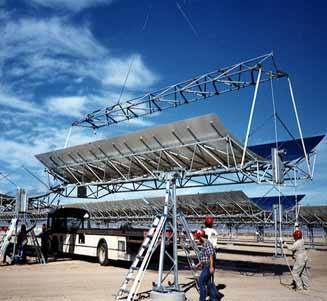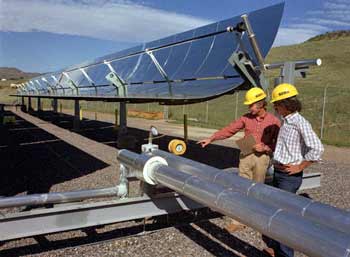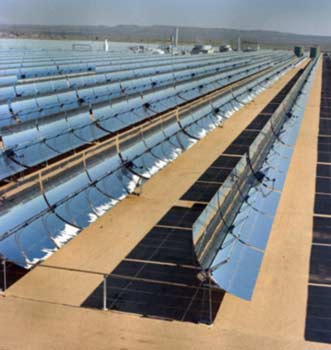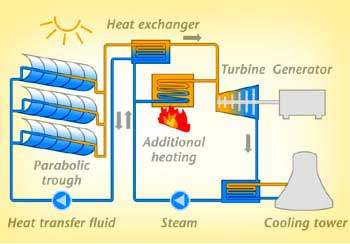 TECHNIQUE
du SOLAIRE THERMIQUE
TECHNIQUE
du SOLAIRE THERMIQUE
Documentation technique
SOLAIRE à haute température
A New Chapter Begins for Concentrated Solar Power
(Nevada)
Companies break ground on the first Concentrated Solar
Power project in more than 15 years
by Jesse Broehl, Editor, RenewableEnergyAccess.com
http://www.renewableenergyaccess.com/rea/news/story?id=43336
http://www.solargenix.com/
February 11, 2006

Construction began this weekend on Nevada Solar One,
a 64 MW solar trough-style Concentrated Solar Power project.
Photo: NREL
This weekend, in the Desert outside Las Vegas, a
major milestone was reached for renewable energy that could represent a
shift in how the fastest growing region in the U.S. get its energy. Hundreds
of people from around the world were on hand in Boulder City, Nevada, to
commemorate the groundbreaking for the beginning of construction on the
first Concentrated Solar Power (CSP) energy project in the U.S. in more
than 15 years.
Called Nevada Solar One, the 64 MW commercial-scale
solar energy plant will encompass 350 square acres, a nearly endless sea
of mirrored troughs that will concentrate the strong desert sunlight and
convert it into 750°F thermal energy, which can then be used to create
steam for electrical power generation.
A combination of state policies and support from
both the Governor and the legislature, steady advances in this type of
technology, all coupled with skyrocketing energy costs have helped make
this unique project a reality.
"Nevada has proven to be very forward thinking
in promoting solar and other renewables," said Solargenix President
John Myles. "The main factor here is that you can get very large blocks
of power coming from solar energy in one single location. It is very clearly
the lowest cost solar energy that can be produced today."
The project is designed and led by Solargenix Energy,
based in North Carolina, but involves a host of companies from around the
world. The groundbreaking this weekend also made official a partnership
between Solargenix and Spain's renewable energy giant, the Acciona Group,
which has acquired a 55% interest in the commercial power plant division
of Solargenix.
Gilbert Cohen, Vice President of Engineering &
Operations for Solargenix, said the project costs somewhere in the range
of $220-250 million. He said the power is slightly more expensive than
wind power, but less than photovoltaic (PV) power, more commonly used in
small rooftop projects on homes or businesses. Other sources close to the
project put this price at somewhere between 9-13%/kWh. As more are built,
however, and they're scaled up even bigger, Cohen says a target of seven
cents per kWh will not be difficult to reach in the near future.

The Nuts and Bolts of Nevada Solar One
Germany's glass specialists, Schott -- a company
familiar in the solar industry for their solar photovoltaic modules --
is one of the primary equipment suppliers. In its first large-scale solar
thermal contract, Schott is providing more than 19,000 of their latest
vacuum tube steel and glass receivers, which in many ways can be considered
the heart of the project. It is these receiver tubes that the parabolic
mirrors focus the sun's energy on and they, in turn, absorb the solar radiation.
Flabeg, also a German company, will provide the mirror panels or troughs
while industrial giant Siemens of Sweden will provide the 75 MW turbine.
Many other companies are involved in other aspects
of hardware and construction, including the main construction contractor
Houston-based EPC, Phoenix-based Hydro, which is building the aluminum
tracking frames that hold the mirrors. Israel-based Solel is providing
some backup receivers in case there are any supply issues with the Schott
receivers, according to Cohen. In all, as many as 750 people will be involved
in the construction and the power plant will have a full-time staff of
28.
Contrary to some press accounts, the project is
not the largest of its kind in the world. Nor is it the first. There are,
in fact, nine similar projects in the Mojave Desert in California -- two
of them 80 MW in size -- that are operating above and beyond original expectations.
According to experts involved in the project, however, there are subtle
but significant changes made to this new version that will improve the
overall efficiency and cost.

The older plants in the Mojave Desert, called SEGS,
for Solar Electric Generating Stations, were different in a number of ways.
Those plants required a 25% natural gas-fired backup to keep the heat transfer
fluid temperature from fluctuating wildly. Nevada Solar One is designed
to be more efficient in holding its temperature and requires only a 2%
natural gas backup. More efficient and reliable motors will be used to
move the troughs that track the sun. The frames for these troughs are now
built out of lightweight aluminum instead of galvanized steel.
The receivers themselves are different as well.
Christoph Fark, global manager for sales and marketing for Schott's solar
thermal division, says the close to 19,000 receivers used in the project
are the first commercial application of a new design from the company.
The receivers must be designed to withstand the daytime highs of 750 degrees
F and the lower temperatures at night. This can be particularly challenging
to the seal between the outside glass tubing and the vacuum-packed steel
receiver inside that holds the heat transfer fluid, a special synthetic
oil. Fark explained how Schott invented a type of glass with the same thermal
coefficient as steel so the two materials would react in unison to the
constant temperature stresses.
These complex receivers are currently made in Germany
but if CSP technology becomes a bigger player in the American Southwest,
Fark suspects they could move some production into the U.S.
"We see this as the beginning, we are involved
in project discussion worldwide -- such as the southern parts of Europe,
the Mediterranean and the Middle East," Fark said. "We hope the
market picks up, and if so, then Schott is willing to invest in the production
side in the U.S. This is our overall strategy, to be where the customer
is. We believe the U.S. market offers huge potential for this technology."
The Right Place at the Right Time
On a broader scale, Nevada Solar One reflects a
symbolic rekindling of this technology approach, one that many experts
say is particularly well-suited for areas like the American Southwest where
sunlight is abundant but energy is precious and increasingly strained by
population growth.
"This is a technology the utilities are comfortable
with, it has proven reliability, it lends itself to economies of scale,
there clearly is still some room for price reduction, and also it's a way
to get large amounts of renewable energy deployed rapidly," said Chuck
Kitscher, Principle Engineer and Group Manager of the Thermal Systems Group
at the National Renewable Energy Laboratory. "If we want to get serious
about reducing carbon dioxide emissions and lower our use of fossil fuels,
this is a way to quickly address that. I'm very optimistic about this technology."
A wide variety of factors have collided -- everything
from politics to the marketplace -- to make this project a reality.
"After many years the time has come where we
don't have to explain anymore the need for renewable energy, we don't have
to explain the concerns about climate change, we don't have to explain
the instability created by oil resources that belong to only a few countries
when all countries are using these resources. Nor do we have to explain
the instabilities to energy from disasters like hurricanes," said Alberto
De Miguel, Acciona's Director of Corporate Development and Strategy. "Renewable
energy is now accepted more than ever by the public."
And that public acceptance is increasingly being
turned into policy. Nevada is one of a growing number of states with a
mandate that electric utilities, in this case Nevada Power Co. and Sierra
Pacific Power Co., source a slowly escalating percentage of their power
from renewable resources. Eventually the two utilities will have to reach
20 percent renewable energy use by 2015. The law also contains a so-called
"solar cut-out" that requires at least one-fourth of that power to come
from solar energy. The project is projected to generate 130,000 MWh of
power per year over the course of its decades-long lifetime. All of its
electricity production will be sold to Nevada Power and Sierra Pacific
Power under long-term power purchase agreements to help them meet this
requirement.
A Natural Fit for Tomorrow's Market
While Nevada's policy played a very strong role
in supporting this project, perhaps the next most influential factor is
the natural gas market where prices have skyrocketed. This is at the core
of why experts inside and outside of Solargenix believe CSP will play an
increasingly important role in helping the rapidly growing American Southwest
to meet its energy demands.
"There are fundamental differences in the electricity
marketplace versus 15 years ago," said Rhone Resch, Executive Director
of the Solar Energy Industries Association (SEIA), who was involved in
the natural gas industry before joining SEIA.
"Natural gas and peak power is incredibly expensive.
Utilities are scrambling to find power generation sources that are reliable
for peak power," Resch said. "Those changes are going to be what
drives new plants like this. The beautiful thing with this project is that
it offers firm, dispatchable peak power."

Resch said utilities and the ratepayers they serve
made an investment in natural gas for the coming decades as a transition
fuel but they are finding out now that it's too expensive to afford. The
power plants are fine, but the energy commodity is becoming cost prohibitive
and coal is often the next best option. This is relevant and fortuitous
for CSP technologies because natural gas power plants are not fundamentally
so different than a CSP plant. Just as today's fleet of natural gas plants
uses a fossil fuel to create steam for a turbine, CSP plants like Nevada
Solar One also create useable, commercial-scale steam, except only from
the sun's energy, a consistently free and available resource.
"Except for the troughs, everything else is a
standard natural gas plant," said Scott Sklar, industry consultant
with the Stella Group. "That's what Solargenix has always maintained,
you're really buying a natural gas power block with solar attached. It
can't be that risky, after all the old SEGS plants have been up and have
operated close to flawless."
In addition to the power plant side of the project
being something the utilities and the traditional power industry is familiar
with, Sklar said these types of projects can be easily deployed close to
where the power is needed, unlike commercial wind power where the best
wind resources are often not near where the power is needed. And while
wind power may offer a slightly lower cost per watt than CSP, wind power
generation is intermittent, whereas CSP offers consistent power all day
long when energy demands are highest.
"I dealt with this all the time, in the early
days when Washington pundits and other people thought solar thermal would
go nowhere," Sklar said. "Or they would say 'this stuff is great
but it just isn't in sizes big enough to matter.' Well this is pretty substantive.
It's exciting and I think it will create a whole revival towards concentrated
solar power in the U.S."
The project is scheduled to begin production of
electricity in March of 2007.




